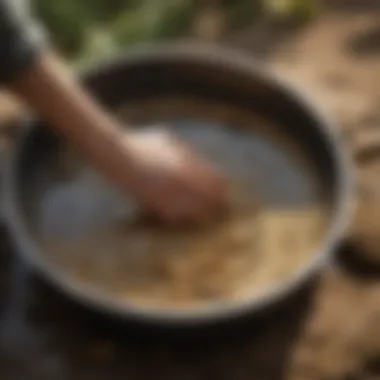Mastering Gold Panning: Techniques and Tips


Intro
Gold panning is a practice steeped in history, one that has captivated prospectors and enthusiasts alike for generations. This simple technique allows individuals to sift through sediment in rivers and streams to uncover the elusive yellow metal. While it may seem straightforward, there are nuances to gold panning that can significantly affect the outcomes of a search. This guide aims to unravel those intricacies.
In this comprehensive guide, we will explore the essential techniques for effective gold panning. We'll discuss the proper equipment, the best locations to search, and the methodologies that improve the chances of finding gold. Furthermore, this article will address the environmental considerations tied to gold panning practices, emphasizing the necessity for sustainability in this endeavor.
Gold panning is not just about treasure hunting; it is a connection to nature and history. For both novices and seasoned prospectors, having a profound understanding of the techniques involved is critical to success. The following sections will provide valuable insights, combining practical tips with deeper knowledge about this rewarding activity.
Prelude to Gold Panning
Gold panning has long fascinated individuals seeking affluence and adventure. This practice, which dates back centuries, involves sifting through riverbeds to uncover gold particles. The importance of gold panning extends beyond mere fortune; it encapsulates history, culture, and the relationship between humans and nature. In this article, we will explore various facets of gold panning, showcasing its techniques, equipment, and environmental impacts.
Historical Context
The history of gold panning is rich and varied. It began in ancient times when civilizations first discovered the beauty and value of gold. Cultures across the world have engaged in gold prospecting, which often led to migration and the establishment of towns and economies based on the gold rush.
In the mid-19th century, the California Gold Rush spurred a significant migration of people hoping to strike it rich. Many abandoned their previous lives and ventured westward, driven by the allure of shiny nuggets. This historical context highlights how gold wasn't just a metal, but a catalyst for change, impacting economies and societies deeply.
Cultural Significance
Gold panning holds considerable cultural significance. It represents human resilience and the pursuit of dreams under challenging circumstances. Various cultures have created legends and tales surrounding gold, fortifying its allure. For many, gold panning fosters a sense of community. Enthusiasts often gather at rivers, sharing stories, techniques, and camaraderie.
Additionally, gold has deep-seated symbolism across different societies, often associated with prosperity, purity, and divinity. As society progresses, the continuing interest in gold panning speaks to our enduring aspirations for wealth, adventure, and connection to the natural world.
Gold panning is not just a hobby; it is a journey through time, connecting us to our past and to each other.
Understanding Gold
Understanding gold is fundamental within the scope of gold panning. This section highlights why comprehending the characteristics and origins of gold can greatly impact the effectiveness of panning techniques. Gold has been valued for centuries, not only for its beauty but also for its inherent qualities. Gaining insight into these properties and formation processes can help both novice and experienced prospectors make informed decisions while panning.
Properties of Gold
Gold is a unique metal with several important properties. Its density is quite high, which is key during the panning process. Gold's specific gravity is approximately 19.3, meaning it is heavy enough to settle at the bottom of a pan or sluice box. This quality allows prospectors to separate it from lighter materials.
Another notable property is malleability. Gold can be shaped without breaking. This aspect plays a role not only in jewelry making but also when considering the type of gold you may find. Larger nuggets may indicate a more recent, localized source, while fine particles often suggest erosion from distant veins.
Gold also has a lustrous yellow color due to its ability to reflect light. This high reflectivity and durability makes it resistant to tarnishing. As such, artifacts made from gold often survive the test of time, providing insight into ancient cultures.
Formation Processes
Gold formation occurs through two primary processes: hydrothermal action and placer formation. Hydrothermal processes involve the movement and solidification of mineral-rich water from deep within the Earth. As the water cools, gold precipitates out and can become trapped in rock formations.
Placer deposits, on the other hand, are formed by the weathering of these rocks over time. Erosion and natural forces, such as water flow, transport the gold particles into riverbeds and silt deposits. Understanding these processes helps prospectors identify locations where gold is more likely to concentrate.
This knowledge equips panners with the ability to assess their chosen site effectively. For instance, areas near bedrock or those with swift-moving currents are often hotspots for gold deposits, making them ideal targets during panning excursions.
Essential Equipment for Panning
Gold panning is a sensitive art that demands the right tools to increase the likelihood of a successful find. The choice of equipment can greatly affect both the ease and efficiency of the panning process. In this section, we discuss the essential equipment needed for effective gold panning, detailing specific elements, benefits, and considerations surrounding optimal selections.
Choosing the Right Pan
The gold pan is the most critical item for any prospector. It comes in various materials, primarily plastic and metal. Plastic pans are lightweight, rust-proof, and easier to carry, making them a popular choice among beginners. On the other hand, metal pans offer durability and a more traditional feel but can be heavier. When selecting a pan, consider the size and the design of the riffles. Riffles are small ridges or grooves that help trap gold particles as you wash away lighter materials.


The diameter of the pan also matters. A larger pan allows more material to be processed at once but can be cumbersome. A smaller pan is easier to handle but limits the amount of raw material you can wash at one time. Overall, choose a pan that balances size and weight according to your panning location and personal preferences.
Additional Tools
Beyond the basic pan, additional tools can significantly enhance your gold panning experience. These tools help with material preparation, separation, and overall efficiency. Here, we cover three important additional tools: the classifier, the sluice box, and the trowel.
Classifier
A classifier is a sieve that separates larger rocks from the fine material that may contain gold. This tool not only simplifies the initial sorting process but also helps in maximizing the efficiency of gold recovery. By using a classifier, you can ensure that the material you pan is mostly fine, which improves the chances of finding gold.
The key characteristic of a classifier is its mesh size. Different classifiers come with various mesh sizes; a finer mesh boasts more separation capabilities, but may slow down the process since it takes longer to sift through the material. Thus, selecting a classifier that matches your panning environment can augment your overall efficiency.
Sluice Box
A sluice box serves as a more advanced tool for catching gold particles from larger amounts of sediment. It uses the current of water to separate the gold from lighter material. The sluice box is particularly popular among those who are willing to do a bit more work and want to process more material.
The main advantage of a sluice box is its ability to handle larger volumes of material compared to manual panning. This means that you can increase your productivity significantly. However, a sluice box requires a water source and a bit more setup, which could be seen as a disadvantage for casual panners who prefer something more portable.
Trowel
A trowel is essential for digging and moving materials from the riverbank or streambed into your pan. It is a simple yet vital tool that allows you to extract materials without much hassle. A trowel is small enough to carry easily, yet sturdy enough for efficient digging.
The beneficial aspect of a trowel is its versatility. It can be used to pry up rocks or even to create small shallow holes for collecting more material. Choosing a trowel with a comfortable grip can make your digging process less physically demanding.
With these essential tools in hand—your gold pan, classifier, sluice box, and trowel—you can prepare effectively for gold panning. Each tool serves a specific role, enhancing your chances of a successful prospecting experience. Keeping these considerations in mind will help you maximize your gold panning potential.
Techniques for Effective Gold Panning
Gold panning is more than just a casual recreational activity. It requires a methodical approach to increase the likelihood of success. In this section, we will explore how effective techniques can significantly enhance gold recovery. Focusing on site selection and the panning process, these strategies will provide you with a foundational understanding that can be applied in various environments. The right technique not only improves yield but also lowers frustration, making this time-honored practice more enjoyable.
Site Selection
Choosing the right site for gold panning is perhaps the most crucial step in the entire process. Selecting optimal areas can be the difference between a successful outing and returning empty-handed. Understanding local geology and terrain is essential for this purpose.
Identifying Gold-rich Areas
Identifying gold-rich areas requires an understanding of geological formations and historical gold findings. Gold typically resides in riverbeds, particularly where water slows down and sediment accumulates. Look for signs such as:
- Bedrock exposure: This can indicate ancient riverbeds where gold might be trapped.
- Depressions in the riverbed: These features may trap gold particles.
Knowing these characteristics aids in focusing your efforts. Gold-rich areas not only yield more gold but also provide a greater likelihood of profitable finds. However, persistent research is required as conditions may change.
"Understanding the geological context of an area is foundational for successful gold panning."
Assessing Water Sources
Water is another vital element in gold panning. Not all bodies of water are suitable for panning. Assessing water sources involves checking flow rates and clarity. Efficient flowing water tends to wash away lighter materials but can also carry gold downstream. Key aspects to consider include:
- Stream speed: Ideally, rivers that flow moderately are best for gold recovery.
- Clarity: Clear water often indicates that the sediment is moving, which may mean less chance for gold to settle.
Evaluate these factors carefully to enhance your prospecting capabilities. Rivers with fluctuating water levels can also present unique challenges and opportunities, and thus careful planning is necessary.
The Panning Process


Once you have identified promising sites, the next step involves the actual panning process. This encompasses gathering materials, employing effective washing techniques, and learning to detect gold efficiently. Each component plays an integral role in optimizing your chances of a successful endeavor.
Gathering Material
Gathering material is crucial in creating the foundation for an effective panning session. Choose sandy and gravelly areas where water has deposited sediments. Skimming the top layers can often yield a wealth of potential finds. Important considerations should include:
- Depth of material: Focus on about 6 to 12 inches below the surface.
- Diversity of materials: Mixing materials from different parts of the same area can increase the likelihood of finding gold.
These actions can maximize your yield as well as minimize time spent on less productive areas.
Washing Techniques
Washing techniques are vital to the extraction process. Effective washing removes lighter materials, allowing heavier gold to settle. You should focus on employing the right movements, such as:
- Circular motion: This helps agitate the materials without losing valuables.
- Gradual removal of water and gravel: Slow and steady is key to avoiding accidental loss of gold.
Properly executed washing techniques are beneficial in maintaining focus on the heavier elements throughout the process. Good technique can yield more gold while also increasing efficiency during longer panning sessions.
Detecting Gold
Detecting gold is the final step in an already engaged process. Recognizing what gold looks like within the pan is essential. Remember:
- Look for luster: Real gold has a distinctive gleam that sets it apart from most sediment.
- Weight: Gold is much heavier than most other minerals, making it easily recognizable when compared to surrounding materials.
Strengthening your ability to detect gold increases your overall success rate. Developing a keen eye and practiced hand will eventually lead to more rewarding finds.
Environmental Considerations
Gold panning, while a time-honored practice, carries inherent environmental responsibilities. Understanding these responsibilities is crucial for prospectors who wish to engage in the activity sustainably. Environmental considerations encompass the impact of gold panning on ecosystems and the legal frameworks governing the practice, both of which are essential for preserving natural environments and ensuring the longevity of gold panning as a recreational activity.
Impact of Panning on Ecosystems
The act of panning for gold can significantly affect local ecosystems. When prospectors disturb the riverbed, they may inadvertently displace sediments and other materials. This can lead to increased turbidity in the water. High turbidity levels can harm aquatic life, as organisms like fish are sensitive to changes in their habitat. In addition,
- Habitat Disruption: Gold panning often requires the removal of vegetation along riverbanks. This practice can lead to soil erosion and loss of habitat for many terrestrial species.
- Water Quality Degradation: Chemicals used in other mining activities or even residue from mining equipment can contaminate water sources.
To mitigate these impacts, prospectors should adopt sustainable practices. For example, using dry panning techniques can reduce the need for significant water use, thus lessening the overall ecological footprint. Furthermore, dredging and other invasive methods should be avoided to preserve water clarity and habitat integrity.
"Preservation of natural habitats should be a priority for all who engage in gold panning."
Legal and Regulatory Issues
Regulatory frameworks surrounding gold panning vary significantly by region and are designed to protect both the environment and the rights of local communities. Understanding these regulations is paramount for anyone looking to prospect legally and ethically. Non-compliance can results in hefty fines and even legal penalties.
The key legal aspects to consider include:
- Permits: Many regions require specific permits for panning in designated areas, especially in protected lands or waterways.
- Restrictions: Some areas prohibit gold panning altogether to protect fragile ecosystems or historical sites. Always check local regulations before embarking on a panning trip.
- Environmental Stewardship: Many jurisdictions include guidelines that promote sustainable practices aimed at minimizing the ecological footprint of prospecting activities.
Engaging in the discourse around sustainable gold panning can promote both a thriving gold panning community and a healthier planet.
Challenges in Gold Panning
Understanding the challenges in gold panning is crucial for both novice and experienced prospectors. This section examines the different obstacles that individuals may encounter while engaging in this classic pursuit. By unveiling these challenges, this narrative aims to prepare readers for the realities of gold panning, emphasizing the need for effective strategies and safety protocols.


Physical Strain and Safety
Gold panning can be physically demanding. The act of bending over for extended periods, coupled with the repetitive motion of panning, can lead to fatigue and muscle strain. People often ignore the physical toll of this activity, which can lead to injuries. Ergonomics should be a priority. To mitigate risks, it is advisable to take regular breaks, stretch, and maintain proper posture throughout the process.
Consideration of terrain is also essential. Panning often occurs near water, which can introduce additional hazards. Slippery rocks, uneven ground, and sudden weather changes can create dangerous conditions. To enhance safety:
- Wear appropriate footwear with good grip.
- Bring first aid supplies in case of minor injuries.
- Stay informed about weather patterns and water levels.
Taking these precautions protects the individual, ensuring that gold panning remains an enjoyable endeavor.
Dealing with Competitors
Gold panning can be a competitive activity, especially in known gold-rich areas. This environment can create challenges that require strategic responses. Often, prospectors may find themselves vying for the same spots, leading to disputes and tensions. It is important for individuals to adopt an ethical mindset and practice manners when engaging with other prospectors, as this promotes a sense of community.
To succeed in such environments, one should consider these approaches:
- Scout New Locations: Seek less popular areas where competition may be lower.
- Time Management: Choosing the right time to pan can be critical. Early mornings or late afternoons may see fewer people.
- Networking: Building relationships with other gold panners can lead to shared knowledge about effective sites and strategies.
Being aware of these challenges helps individuals navigate the complexities of competition, ultimately enhancing the gold panning experience.
Advanced Gold Panning Strategies
In the quest for gold, employing advanced strategies can significantly enhance the likelihood of success. This section delves into innovative approaches that go beyond traditional panning methods. By integrating technology and fostering collaboration among prospectors, enthusiasts can maximize their efforts and make the experience more fruitful.
Using Technology
Metal Detectors
Metal detectors are a game-changer in gold prospecting. They operate by sending electromagnetic waves into the ground, detecting changes in the magnetic field caused by metallic objects. This technology has become increasingly popular owing to its effectiveness at locating nuggets that might be missed by manual panning methods.
One key characteristic of metal detectors is their sensitivity. Advanced models can detect small gold particles even at considerable depths. They are especially beneficial for those working in large areas or rocky terrains where traditional panning is challenging. However, their use requires some training to differentiate between gold signals and other metal signals, which can cause frustration for new users. Despite this, the chance of finding larger gold pieces easily makes metal detectors a worthwhile investment for serious prospectors.
GPS Tools
GPS tools provide significant advantages in modern gold panning. They help prospectors pinpoint exact locations, track routes taken, and remember fruitful spots. This technology is instrumental when a panner wishes to revisit successful sites or avoid previously unproductive areas.
One notable feature of GPS devices is their ability to create detailed maps of the area. This capacity allows prospectors to analyze terrain features, find water sources, and identify potential gold-rich zones with detail. However, they may be less effective in dense forests or areas with poor satellite signals. Nonetheless, the strategic advantages offered by GPS tools often outweigh these limitations, making them a crucial resource in the toolkit of prospectors.
Collaborative Prospecting
Collaborative prospecting revolutionizes how gold panners interact and share information. By teaming up, prospectors can combine their skills and resources, resulting in more efficient searches. This approach encourages sharing knowledge about techniques, sites, and equipment, fostering a community of learning and support.
Working collaboratively can also enhance safety. When multiple people are present, the physical demands of panning and the potential risks associated with remote locations are mitigated. Also, groups can cover more ground, increasing the overall probability of finding gold. In this digital age, social platforms like Reddit have created spaces for prospectors to connect, share experiences, and collaborate on expeditions.
Engaging in collaborative prospecting nurtures a spirit of camaraderie among enthusiasts while significantly boosting individual success in the pursuit of gold.
Closure
The conclusion of this article encapsulates the essence of gold panning techniques and practices discussed throughout. It is crucial to reflect on the various methods and insights shared to understand both the intricacies involved and the rewards that come from effective gold panning.
Reflecting on Techniques and Practices
Throughout this guide, we explored diverse panning techniques and the significance of selecting the right site for prospecting. The practical skills learned can directly enhance one’s effectiveness when searching for gold. Each method outlined, from site assessment to labored washing techniques, provides tools not just for novice prospectors but also for seasoned individuals looking to refine their practices. From our discussions, it becomes evident that experience and adaptability are vital components. Understanding the environment and the effects of one's actions on it plays a key role. Moreover, maintaining a mindful approach towards the natural ecosystems affected by this activity remains fundamental to responsible prospecting.
Future of Gold Panning
As we look ahead, the future of gold panning is influenced by both technological advancements and global environmental considerations. With the introduction of tools like metal detectors and GPS technologies, prospecting has become more efficient, allowing individuals to cover more ground in less time. However, this increased efficiency brings the challenge of sustainability into focus. The rise of responsible prospecting practices ensures that while we hunt for gold, we also protect our natural resources. Collaborative efforts, combined with technological support, may define the next era of gold panning. Engaging with communities online, such as through platforms like reddit.com, allows for the sharing of experiences and tips, benefiting all involved in this age-old practice.
Understanding where gold panning fits into the wider context of ecological preservation and responsible resource management is essential. The balance between the thrill of discovery and the duty to respect the environment determines the future viability of gold panning as both a hobby and profession.







